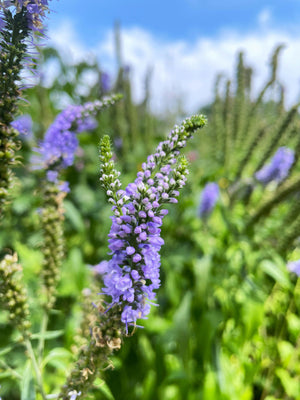The Veronica Guide
Veronica, also known as speedwell, is a genus of hardy perennials admired for their spiky flower clusters, long bloom season, and low-maintenance nature. Available in a range of heights, from ground-hugging varieties to upright flowering spires, veronica brings bold color and structure to sunny garden beds. Its vibrant blooms, often in shades of purple, pink, blue, or white, are a favorite of pollinators and cut flower enthusiasts alike.

About
Veronica includes more than 500 species and cultivars, offering something for nearly every garden design. The genus is split between classic low-growing veronicas like Veronica spicata, upright meadow forms like Veronica longifolia, and taller architectural options like Veronicastrum virginicum (often treated separately but closely related).
- Upright types such as Veronica spicata 'Royal Candles', 'Red Fox', and 'Snow Candles' are known for their narrow spires of vivid blooms.
- Compact cultivars like 'Moody Blues Dark Blue' and 'Bubblegum Candles' are ideal for borders or containers.
- Groundcover selections like Veronica peduncularis 'Whitewater' spread to create a flowering carpet.
- Tall meadow selections like Veronicastrum virginicum 'Fascination' and 'Lavender Towers' add height and movement to naturalistic plantings.
- Unique introductions like 'Purpleicious' and 'Lavender Lightsaber' offer unusual hues and striking foliage contrast.
These adaptable perennials bring beauty from late spring through summer and often rebloom with proper care.

PLANTING
Veronica is versatile and easy to establish in sunny gardens, pollinator habitats, and mixed borders:
- USDA Hardiness Zones: Most varieties are hardy in Zones 4–8.
- Soil: Prefers average, well-drained soil. Amends heavy clay with compost to improve drainage.
- Sunlight: Full sun (at least 6 hours daily) is ideal. Partial shade tolerated in hot southern zones.
- Spacing: Space 12–18 inches apart, depending on variety.
- Planting Time: Best planted in spring or early fall to allow root establishment before extremes of heat or frost.
Plant at soil level and water thoroughly. Mulch around the base to conserve moisture and reduce weed pressure without crowding the crown.

CARE
Once established, veronica is remarkably easy to maintain and rewards you with consistent flowering:
- Watering: Moderate water needs. Water regularly during dry spells, especially during establishment.
- Fertilizing: Feed with a balanced, slow-release fertilizer in spring. Over-fertilization can lead to leggy growth.
- Deadheading: Remove spent flowers to encourage rebloom and prevent unwanted self-seeding.
- Pruning: Cut back to the ground in late fall or early spring. Taller varieties may benefit from midseason shearing to maintain shape.
- Dividing: Divide every 3–4 years to reinvigorate clumps and prevent overcrowding.
- Pest & Disease Resistance: Generally disease- and pest-resistant, though some varieties may be susceptible to powdery mildew in humid conditions. Provide good air circulation to prevent issues.

HOW TO USE
Veronica offers a wealth of design possibilities thanks to its range of colors, heights, and forms:
- Borders & Edging: Use compact cultivars like 'First Love', 'White Wands', or 'Pink Potion' along paths and garden edges.
- Pollinator Gardens: Pair 'Sunny Border Blue' or 'Very Van Gogh' with echinacea, monarda, and rudbeckia to attract bees and butterflies.
- Cottage Gardens: Mix spiky veronicas with daylilies, phlox, and coreopsis for an informal, layered display.
- Groundcovers: Spreaders like Veronica peduncularis 'Whitewater' and 'Waterperry Blue' are excellent for filling in under shrubs or softening rock walls.
- Tall Background Plantings: Use Veronicastrum virginicum 'Pink Glow' or 'Erica' as vertical accents in perennial borders.
- Containers: Smaller varieties such as 'Moody Blues Pink' perform well in pots with good drainage.
Pair veronica with companions like salvia, sedum, shasta daisy, yarrow, or nepeta to create bold, long-lasting plant combinations.

COMMON QUESTIONS
- How to care for veronica? Provide full sun, moderate water, and occasional deadheading. Cut back after bloom and divide every few years to maintain vigor.
- Is veronica toxic to dogs? Veronica is not considered toxic to dogs.
- Is veronica toxic to cats? Veronica is not considered toxic to cats.
- Do deer eat veronica? Veronica is generally deer resistant due to its bitter taste and foliage texture.
- Do rabbits eat veronica? Veronica is rarely targeted by rabbits.
- How big does veronica get? Most varieties range from 10 to 36 inches tall, depending on species and cultivar.
- Are veronica perennials or annuals? Veronica species are herbaceous perennials that return year after year.
- How to care for veronica plants? Provide full sun, well-drained soil, and moderate moisture. Deadhead regularly and divide every few seasons for best results.
Conclusion
Veronica is a must-have perennial for gardeners seeking long-lasting blooms, upright form, and pollinator-friendly performance. With cultivars ranging from tidy clumps to tall, architectural statements, there's a veronica for nearly every garden style. Easy to grow, largely pest-free, and reliably hardy, this classic garden plant offers both function and beauty season after season.
The Veronica Collection
Sold Out
Sold Out
Sold Out
Sold Out
Sold Out


